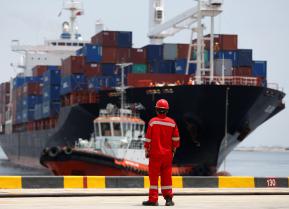China vs. America: Could a Trade War Spark a Shooting War?
History has some answers.
The United States has experienced a wider and faster shift on basic questions of trade policy in less than two years than in the previous seven decades. From a broad bipartisan consensus in favor of liberalized free trade guaranteed by multilateral agreements — a consensus long contested by politically marginal elements on both the left and right — Pres. Donald Trump has reinvigorated protectionism.
He rejected the most significant multilateral trade deal in recent years, the Trans Pacific Partnership, while putting one of the U.S. economy’s bedrock trade agreements, NAFTA, on the hot seat.
On top of all of this he has raised tariffs on steel and aluminum, imposed and proposed significant new tariffs on more than $200 billion of Chinese goods, claimed credit for devastating the Turkish economy in retaliation for their arrest of a Christian evangelist with U.S. citizenship and cancelled the Iran Nuclear Deal, reestablishing sanctions intended to isolate that country.
The previous consensus was built in large part on the idea that expanding global trade made the world a safer place. If countries are all customers and vendors for each other, why would they want to go to war? Of course, whenever a smaller, poorer country tried to support their domestic industries like the big, rich countries do, guns started blazing, but as long as they could be called “communists” or “terrorists” nobody really minded.
On top of all of this he has raised tariffs on steel and aluminum, imposed and proposed significant new tariffs on more than $200 billion of Chinese goods, claimed credit for devastating the Turkish economy in retaliation for their arrest of a Christian evangelist with U.S. citizenship and cancelled the Iran Nuclear Deal, reestablishing sanctions intended to isolate that country.
The previous consensus was built in large part on the idea that expanding global trade made the world a safer place. If countries are all customers and vendors for each other, why would they want to go to war? Of course, whenever a smaller, poorer country tried to support their domestic industries like the big, rich countries do, guns started blazing, but as long as they could be called “communists” or “terrorists” nobody really minded.
Now that America is beefing with bigger, richer countries, however, it raises an important question. Will ratcheting up trade beefs lead to more military confrontation or new kinds of conflict? How likely are trade wars to become shooting wars?
A brief look at history suggests that while it is unlikely for any particular trade spat to lead to a real war, aggressive and protectionist trade policies can have unexpected consequences, some of which make wars much more likely in the long run. None of Trump’s trade moves are likely to send the bullets flying any time soon, but they all make the world a more dangerous place.
Most U.S. trade conflicts since World War II have been between the United States and friendly countries–European countries with disputes over consumer goods, Canada with conflicts over timber, Japan and the struggle over auto imports.
Prior to World War I, however, U.S. trade policy was very different. For decades following the Civil War Congress and the White House were overwhelmingly controlled by the Republican Party. The GOP of that era was dominated by capital-intensive manufacturing interests in the Northeast and agricultural interests in the Midwest.
Recommended: Imagine a U.S. Air Force That Never Built the B-52 Bomber
Recommended: Russia's Next Big Military Sale - To Mexico?
Recommended: Would China Really Invade Taiwan?
Both constituencies saw themselves as threatened by European imports and sought to impose tariff barriers to those industries while securing major federal subsidies in the form of infrastructure development — itself a form of protectionism.
This attitude was reflected in Europe as well, where a series of trade disputes helped lay the foundation for the splits in World War I. After the war, the GOP returned to power in the United States with the election of Warren G. Harding and then Herbert Hoover. The two administrations adopted aggressive protectionist policies, all of which hastened World War II.
First came the Fordney-McCumber Trade Act in 1922. The Act was classic Republican protectionism, but it came right on the heels of a war that had left many countries saddled with dollar-denominated debts. Fordney-McCumber choked off access to dollars, making it difficult to pay the debts. The United States extended loans to Europe, but that only deepened the problem, akin to paying one credit card bill with another credit card.
No country had a bigger problem with war debts, of course, than Germany. In 1921 the London Ultimatum demanded that their debts and the reparations imposed by the Treaty of Versailles be paid back in either gold or foreign currency. Great Britain had likewise engaged in protectionist policies, particularly the 1921 Safeguarding of Industries Act which imposed tariffs specifically on goods from countries with devalued currencies — countries such as Germany.
The downward spiral of Germany losing access to the currencies needed to make its debt payments, seeing its currency devalued, and then having debt payments come due only to see their foreign reserves further stretched and the mark further devalued led to the notorious hyperinflation of the 1920s.
This was a key condition for the rise of the Nazi Party, and global economic depression in the 1930s was responsible for the spread of fascism across the world. The passage of the Smoot-Hawley tariffs in 1931 dramatically increased U.S. tariffs on more than 20,000 goods, an action which economic historians agree exacerbated the Great Depression. Great Britain likewise imposed a 100-percent tariff on all goods manufactured outside the British Empire, and in the wake of these decisions global trade dropped more than 66 percent.
Only the industrial demand of a total war spanning North America, Europe, Asia, Africa and the Pacific could shake the world out of its slump. By the time the war was over U.S. industrial superiority over the devastated economies of Europe and Asia made exports the bedrock of the national economy, discouraging protectionism.
Fears of another conflict like the two that had killed 100 million people in 31 years led to a global economic alliance underpinned by the monetary arrangements established at Bretton Woods in 1944 and the General Agreement on Tarrifs and Trade in 1947. GATT gave way to the World Trade Organization in 1995, and this regime has ruled trade policy in the United States and around the world ever since.
In terms of trade-specific policies, as opposed to issues where trade is explicitly being used in service of larger foreign policy aims as in Turkey and Iran, Trump’s actions all boil down to China. The aluminum and steel tariffs on Europe were targeted less at their steel industries, and more at their consumption of cheap Chinese steel.
One of the largest sticking points of the NAFTA negotiations has to do with what percentage of parts in a car have to be made in North America to exempt it from tariffs, with the non-North American parts largely coming from China.
These sorts of trade pressures designed to make the world choose sides in a major strategic competition have a lot more in common with the sorts of economic hostilities that led up to World War I than they do the fraternal bickering that has characterized post-war economic squabbles.
Still, we have a much better understanding of how tariffs and trade wars affect an entire economy now than we did 100 years ago. Tit-for-tat trade disputes end up harming both parties by raising costs as much as they protect industry. The conflict comes down to which economy can take more damage because every blow strikes in both directions.
The U.S. economy, however, is two-thirds larger than China’s and experiencing a remarkable acceleration of growth after the second longest period of economic expansion in our history. Trump is betting that those factors make us more likely to win, and he’s probably right.
China’s trade manipulation to date has been less about tariffs or even traditional non-tariff barriers such as subsidies, and more about the strategic devaluation of their currency. They are able to do this because they maintain massive reserves of U.S. dollars and other foreign currencies — up to $3 trillion — as well as the largest foreign holdings of US sovereign debt.
When the dollar falls against the yuan they can sell U.S. Treasury bonds to soak up extra dollars and shore up its price; if the yuan falls too far they can buy back those treasuries and add liquidity and inflation to the dollar.
This conflation of trade pressures with currency conflicts poses particular threats. China could conceivably dump U.S. Treasuries, crashing their value and driving up interest rates, which move in the opposite direction of bond prices.
They could also dump dollars, causing significant inflation in the U.S. right as the Federal Reserve has begun to raise the discount rate in response to already existing concerns about rising costs. If either of these were to be done at a large enough scale it may be enough to prompt a military response from the United States right away.


